Panama - crossroads of two oceans
Tiwy.com (July 2007)
|
↓ page 1 - page 2 → |
Canal Zone
Panama is, first of all, the famous Panama Canal that connected the two oceans – Pacific and Atlantic. The history of the Canal is, in fact, the history of Panama itself, a small Latin American country, which, for dozens of years had been struggling for establishing the national control over this waterway.
Administrative building of the Canal. The USA were sovereign owners here till December 1999. At that day the last soldier of the North American army left the territory of Panama, and the Canal came to complete jurisdiction of the country. Nowadays the only symbol of the USA presence remains the omnipresent «McDonald's». At the background of the Administrative building its logo looks like a harmless element of the city scenery.
|
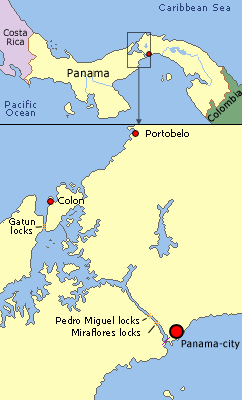 |
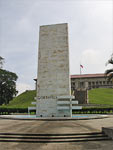
|
At the foot of the hill there is a monument in honour of the engineers who made the design of the Canal and headed its construction.
|
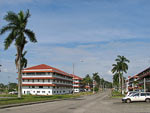 |
In the former Canal Zone where there used to be a US air force base, there remained neat houses that had been built for the US military, who «guarded» the Canal from different kinds of «threats»: «nazi» - in the years of the Second World War, «Soviet» - in the years of the Cold War and, naturally, Panamanian.
|
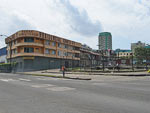 |
Here there was a «border» of the Canal Zone, with numerous night clubs, casinos, cheap brothels and other hot spots along it, in which visitors from the North used to have rest. Main clients shifted to other regions of «extensive threats».
|
|
For many years liberation from the US military presence has been the issue of historic justice for the Panamanians, therefore, the conflicts between the Panamanians and North American military used to frequently spark. In January 1964 a group of students dared to desperate action – to raise the Panama flag at the territory of the Zone. The US military responded with fire. Clashes of students with the Canal guards continued from January 9 to 11. More than 20 students were killed, hundreds were wounded. To commemorate those events a monument to the Heroes of the Panamanian nation has been raised at the former «border».
|
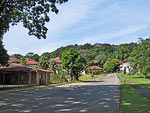 |
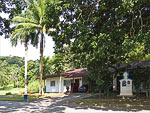
|
Sunk in the well-groomed greenery Albrook – one of the areas of the former Canal Zone, nowadays wealthy people live there. Here a new building of the Russian Federation Embassy is going to be built. At one of its calm streets a Russian Orthodox church is already situated. So far it is rather a simple premises but in future traditional gilded domes will become one of the tokens of Albrook.
|
Panama Canal
|
The best place for observation of the Canal activity – is a range of shipping locks Miraflores, that is situated not far from the capital of Panama. Since the early morning near grey concrete building «mirador Miraflores» - Center of visitors of the Canal – there appears a line of tourists eager to see a «wonder of the world» which used to be considered the Canal.
|
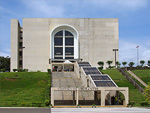 |
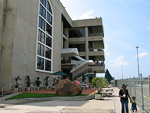 |
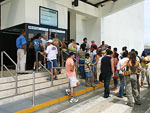 |
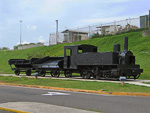 |
Since the time of its construction there remained a touching «museum exhibit» - a smudgy little steam engine with two dumping platforms. You can see these toilers in the height of the construction in the documentaries of the beginning of the XX century. So this little steam engine nowadays is at a well-earned rest!
|
|
As long as the Canal passes through mountain lakes, for «transhipment» of ships there needed a system of shipping locks, that enables to lift up or put down ships in respect of the sea level. Usually it takes 20-24 hours for a ship to cross the Canal. If the ship goes from the Pacific to the Atlantic ocean, her route is the following: Miraflores lock – Miraflores lake – Pedro Miguel lake – Gatun lake – Gatun lake – Atlantic ocean.
|
 |
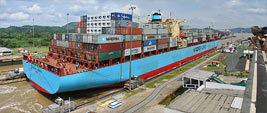 |
According to the statistics almost 14 thousand ships pass the Canal every year. 5% of the world trade is directly linked with the Canal. At the recent referendum the Panamanians have decided to extend and modernise the Canal.
|
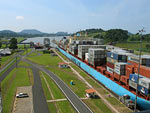 |
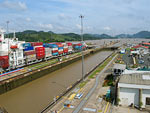 |
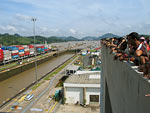 |
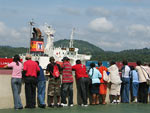 |
Observation points of the Center give the chance to see the process of passing of ships in Miraflores lock in all detail.
|
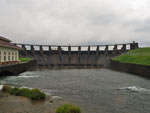 |
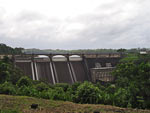 |
Gatun and Madden dams provide for the required reserve of water for rhythmical operation of the Canal.
|
|
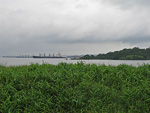 |
 |
The trip along the Canal gives you the idea about the scale of operations on shipment of cargoes.
|
|
|
For couple of hours of stay at the observation points and in the Center museum tourists get comprehensive knowledge on the history of the Canal construction, its first workers, specific features of its functioning. The final phase – visiting of a souvenir shop.
|
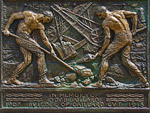 |
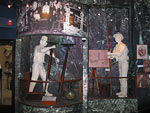 |
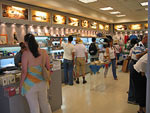 |
Omar Torrijos
President Omar Torrijos (1929-1981) is the most famous Panamanian. He's been conducting long negotiations with Americans on returning the Canal and achieved his goal. 13 years after bloody execution of the students who raised the flag above the Zone, O. Torrijos signed with President J. Carter an agreement on gradual decolonisation of the Canal. Laconic phrase of Torrijos «I don't want to go into history, I want to come into the Zone of Canal» is known by every resident of Panama. But not everybody can indicate the grave of the national leader.
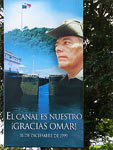 |
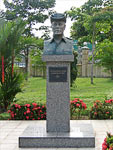 |
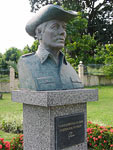 |
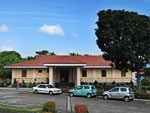 |
Monument to Omar Torrijos in the Center named after him that is situated in Panama-City. Here they study his historic heritage.
|
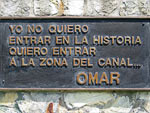 |
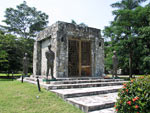 |
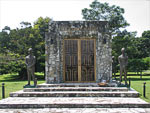 |
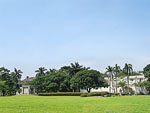 |
Mausoleum of Omar Torrijos in the deserted park of Amador district
|
«School of the Americas»
«School of the Americas» is the place, which is remembered in Latin America with shudder. Here in the Canal Zone, among the beautiful nature, military from the whole continent used to be trained. US instructors trained them to wage an «anti-guerilla war». In reality the «School of the Americas» has prepared dozens and hundreds «experts» in tortures. These specialists were highly appreciated by such dictators as Stroessner, Pinochet, Videla and other just like them.
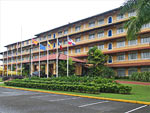 |
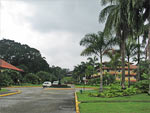 |
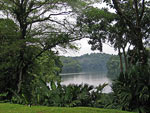 |
Now, the «School of Americas» (under a different name) has been shifted to the USA, and its building is occupied by a luxurious hotel-casino «The Hotel Melia Panama Canal».
|
Bridges over the Canal
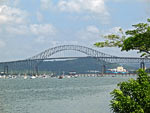 |
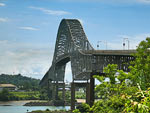 |
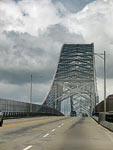 |
Bridges over the Canal - «Bridge of the Americas» (Puente de las Americas) and «Centenario» - are favorite subjects for T-shirts and mugs.
|
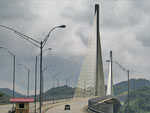 |
Bridge «Centenario» (Puente Centenario) |
Colon
The city of Colon – is a typical port city. There is a «zone of free (i.e. duty-free) trade» there, where cruise vessels moor. Unfortunately in Colon there are a lot of slums where a «typical tourist» is forbidden to go. Drivers of the cars are even afraid to slow down at the city streets. That is why here there are no photos to the subject of «slums in Colon».
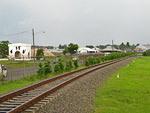 |
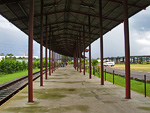 |
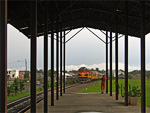 |
Colon is connected with the capital by a railroad, which runs along the Canal. The station in Colon is very simple – just one shed that saves both from hot sun and tropical rain.
|
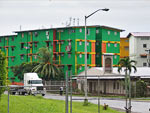 |
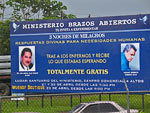 |
Form it one can clearly see «social houses» similar to those that are built in other countries of the continent for not too wealthy residents. The advertising posters of visiting «Chumaks and Kashpirovskiys», «wonder-workers» Luis Diaz Pabon from Miami and Danny Berrios from Puerto Rico are meant for them. It is natural that people rush in crowds to their sessions.
|
|
The railway station in Panama-city is more civilised, where one can have a cup of coffee and standard cheese and ham sandwich, and besides get another souvenir T-shirt with the logo of the road along the Canal. It is quite a pleasure to take a ride in a comfortable carriage from one ocean to the other! And behind the window there are marvelous lake and forest scenes of Panama.
|
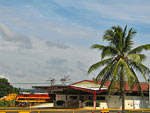 |
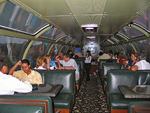 |
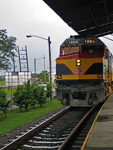 |
Portobelo
|
A small town of Portobelo is situated at the Atlantic shore of Panama. In the colonial times it was a busy center of trade between Spain and its possessions in America. Rather picturesque fortresses and custom house remained since those times.
|
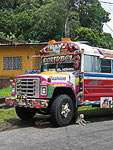 |
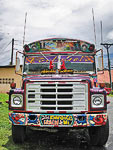 |
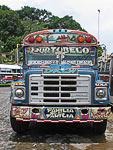 |
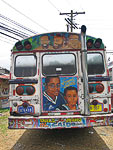 |
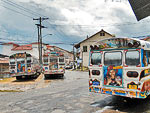 |
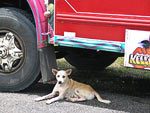 |
Multicoloured buses of Portobelo – are sui generis «Panamanian hohloma». They can be viewed as pieces of art: here everything is intermixed – both Indian patterns, and landscapes and portraits.
|
Our arrival to Portobelo was not very fortunate. It was raining, a grey shroud of clouds covered the sky. The beeches were deserted. Moreover, at that day, the town buried a schoolboy who died of a heart attack right at the football field.
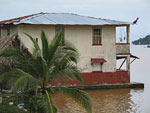 |
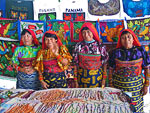 |
Only the souvenir market there seemed to be lively owing to bright needlework of Indians-kunas. Their napkins, bags, blouses are decorated by patches of multicoloured pieces of fabric, sawn by stiff stitches. This patchwork is called «molas». Only those can, probably, be considered 100 percent Panamanian souvenirs.
|
|
Custom house at Portobelo at the times of Spanish crown used to be the main building of the city. The third part of the world gold passed through its vaults! It is because of this reason Portobelo is often mentioned in pirates chronicles. English corsairs «sought to lay hands» on Spanish treasures, but Portobelo remained inaccessible.
|
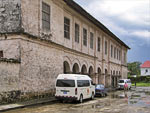 |
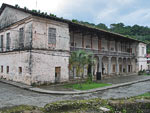 |
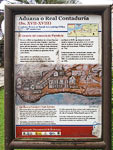 |
According to those times the town was strengthened by one of the most powerful system of forts - Santiago de la Gloria, San Fernando, San Jeronimo. The pirates' ships that tried to break through to the vaults with gold and goods stores, had to retreat in face of the wall of continuous fire. Even nowadays the rows of these long silent guns that are aimed at nowhere, makes you shudder.
San Jeronimo fortress and its patron Saint Jeronimo.
|
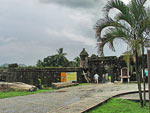 |
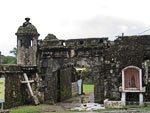 |
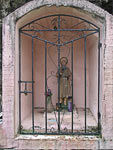 |
San Felipe church is the place of interest of Portobrelo. During its long history it used to be rebuilt, completed, burned after attacks of pirates more than once. But it is famous by another thing: it has a sculpture of «Black Christ». On October 21, believers not only from Panama but from all Central America, come to worship Him.
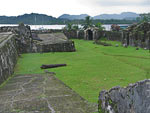 |
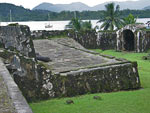 |
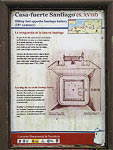 |
Santiago de la Gloria fortress with the walls covered with moss – is a mandatory «stop» for tourists.
|
|
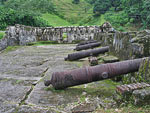 |
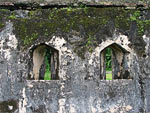 |
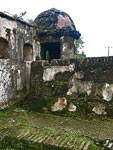 |
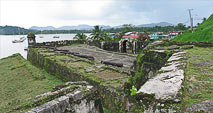 |
Los cañones restaurante
Next stop – is in a roadside restaurant «Los Cañones». The main dish in the menu, of course, is fish.
> Go to the second page of the picture spread «Panama - crossroads of two oceans»
|



